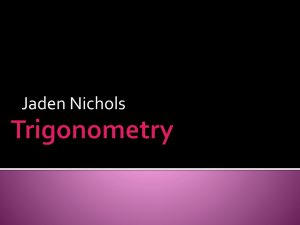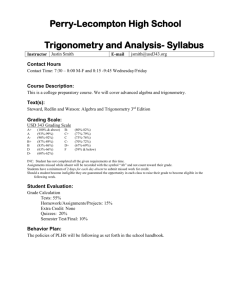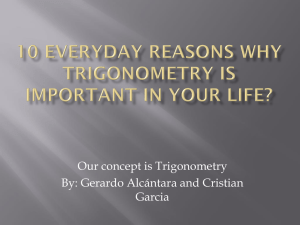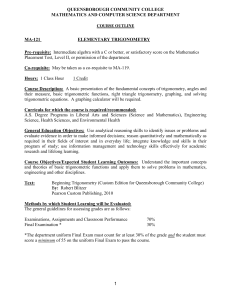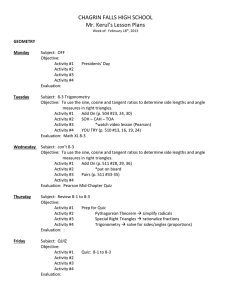trigonometry - WordPress.com
advertisement
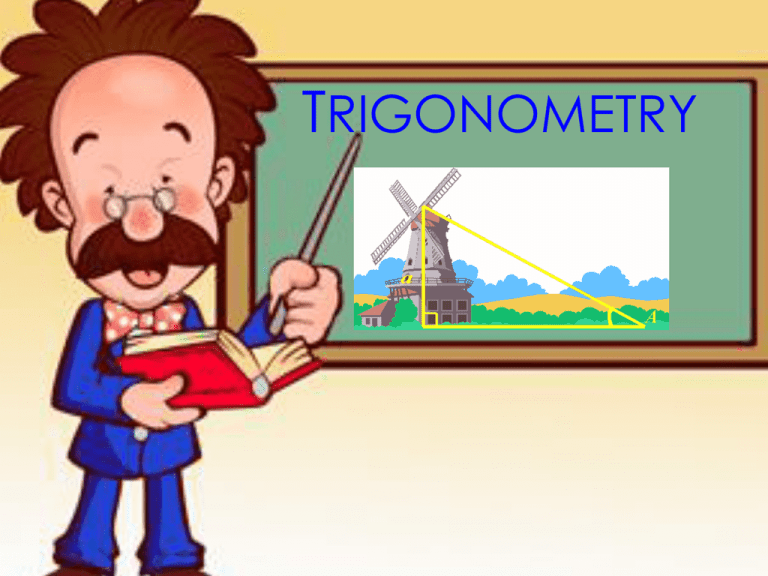
TRIGONOMETRY What is trigonometry? Trigonometry is the branch of mathematics which deals with triangles, particularly triangles in a plane where one angle of the triangle is 90 degrees. Trigonometry is derived from Greek words trigonon (three angles) and metron ( measure). History of trigonometry • The origins of trigonometry can be traced to the civilizations of ancient Egypt, Mesopotamia and the Indus Valley, more than 4000 years ago. • Some experts believe that trigonometry was originally invented to calculate sundials, a traditional exercise in the oldest books • The first recorded use of trigonometry came from the Hellenistic mathematician Hipparchus circa 150 BC, who compiled a trigonometric table using the sine for solving triangles. • The Sulba Sutras written in India, between 800 BC and 500 BC, correctly compute the sine of π/4 (45°) as 1/√2 in a procedure for circling the square (the opposite of squaring the circle). • Many ancient mathematicians like Aryabhata, Brahmagupta,Ibn Yunus and Al-Kashi made significant contributions in this field(trigonometry). In a right triangle, the shorter sides are called legs and the longest side (which is the one opposite the right angle) is called the hypotenuse First let’s look at the three basic functions. SINE COSINE TANGENT opposite sin hypotenuse They are abbreviated using their first 3 letters adjacent cos hypotenuse opposite tan adjacent Trigonometric Ratios Sine(sin) Cosine(cos) Tangent(tan) Cosecant(cosec) Secant(sec) Cotangent(cot) opposite side/hypotenuse adjacent side/hypotenuse opposite side/adjacent side hypotenuse/opposite side hypotenuse/adjacent side adjacent side/opposite side Easy way to learn trigonometric ratios Values of Trigonometric function 0 30 45 60 90 Sine 0 0.5 1/2 3/2 1 Cosine 1 3/2 1/2 0.5 0 Tangent 0 1/ 3 1 3 Not defined Cosecant Not defined 2 2 2/ 3 1 Secant 1 2 2 Not defined Cotangent Not defined 3 1 1/ 3 0 2/ 3 Trigonometric ratios of complementary angles • Sin(90-A)= cos A, Cos(90-A)=sin A • Tan(90-A)= cot A, A Cot(90-A)= tan • Sec(90-A)= cosec A, A Cosec(90-A)= sec Trigonometric identities • Identity1- sin2A + cos2A = 1 • PROOF: • IN TRIANGLE ABC, 2 • AB2 + BC2 = AC2 ( BY PYTHAGORAS THEOREM) • A (1) DIVIDING EACH TERM OF (1) BY AC AB2 / AC2 + BC2 / AC2 = AC2 / AC2 (cos A) 2 + (sin A) 2 = 1 B 2 2 A → cos A + sin = 1 C • Identity2 : 1 + tan2A = • Identity3: 1 + cot2A = cosec2A • Dividing eq (1) by AB2 (AB/AB) 2 + (BC/AB2 =(AC/AB) 2 => 1+ Tan2 A = sec2 A • Dividing eq (1) by BC2 • (AB/BC) 2 + (BC/BC) 2 = (AC/BC) 2 • => Cot2A + 1 = cosec2 A sec2A Solving a Problem with the Tangent Ratio h=? 2 3 60º 53 ft 1 We know the angle and the side adjacent to 60º. We want to know the opposite side. Use the tangent ratio: opp h tan 60 adj 53 3 h 1 53 h 53 3 92 ft Applications of Trigonometry • This field of mathematics can be applied in astronomy, navigation, music theory, acoustics, optics, analysis of financial markets, electronics, probability theory, statistics, biology, medical imaging (CAT scans and ultrasound), pharmacy, chemistry, number theory (and hence cryptology), seismology, meteorology, oceanography, many physical sciences, land surveying and geodesy, architecture, phonetics, economics, electrical engineering, mechanical engineering, civil engineering, computer graphics, cartography, crystallography and game development. Applications of Trigonometry in Astronomy Since ancient times trigonometry was used in astronomy. The technique of triangulation is used to measure the distance to nearby stars. In 240 B.C., a mathematician named Eratosthenes discovered the radius of the Earth using trigonometry and geometry. In 2001, a group of European astronomers did an experiment that started in 1997 about the distance of Venus from the Sun. Venus was about 105,000,000 kilometers away from the Sun . Application of Trigonometry in Architecture Many modern buildings have beautifully curved surfaces. Making these curves out of steel, stone, concrete or glass is extremely difficult, if not impossible. One way around to address this problem is to piece the surface together out of many flat panels, each sitting at an angle to the one next to it, so that all together they create what looks like a curved surface. The more regular these shapes, the easier the building process. Thank you
